Letters from Lodi
An insightful and objective look at viticulture and winemaking from the Lodi
Appellation and the growers and vintners behind these crafts. Told from the
perspective of multi-award winning wine journalist, Randy Caparoso.
A California first—Lodi's Bokisch Vineyards picks Spanish Cava grapes
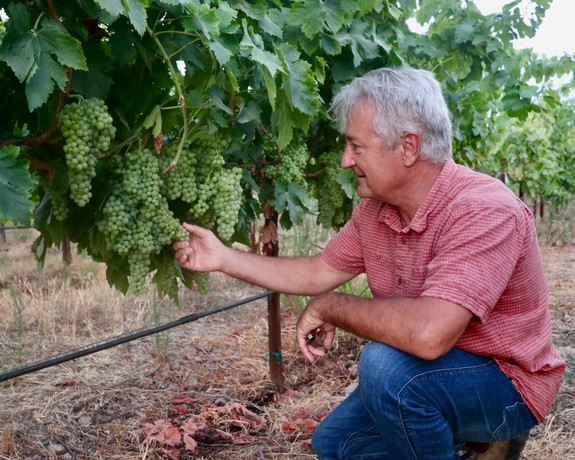
Bokisch Vineyards' Markus Bokisch with a 2023 crop of Macabeu, a Spanish Cava grape now grown in Lodi's Clements Hills AVA.
Look out, world, California is almost ready to become a Cava producer!
California Cava, in actuality, is a misnomer, since Cava means "sparkling wine grown in Spain," and California is obviously not Spain.
Cava, in fact, is what is called a Denominación de Origen (DO), applicable only to sparkling wines made in one particular part of Spain in the vicinity of Catalonia's Penedès region, in the same way France's Champagne only comes from the Champagne appellation in France.
Spain's Cava, however, is primarily made from three white wine grapes, called Macabeo, Parellada, and Xarel-lo (the latter, pronounced cha-RELL-lo in Catalonia). Which is why, somewhat facetiously, we are talking about "Cava in California": For the past four years, Bokisch Vineyards—Lodi's (and California's, for that matter) leading Spanish grape specialist—has been cultivating these exact same Cava grapes in their Miravet Vineyard, located at the northern edge of Lodi's Clements Hills AVA.
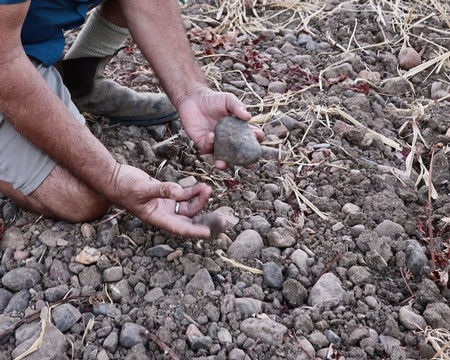
Extremely rocky, hillside volcanic soil is found at the northern edge of Lodi's Clements Hills AVA in Bokisch's Miravet Vineyard.
Although Clements Hills is known primarily for reddish, gravelly, volcanic hillside soils, Bokisch's Miravet is located so close to the neighboring Borden Ranch AVA (just a few feet away) that its soils are actually hillier, although also volcanic, but rather than gravelly the rocks range closer to fist or boulder sizes. This type of topography can stress grapevines significantly, but under Lodi's ceaselessly warm, bright sun—enhanced by Miravet's east (i.e., afternoon sun) facing slopes—these native Spanish grapes already seem to be thriving.
At the crack of dawn this past week, Markus Bokisch took the time out of his normally hectic schedule to go through the vineyard with me, talking about all the exciting things he, his co-owner/wife Liz and their entire, tight-knit Bokisch Vineyards team has in store for these grapes.
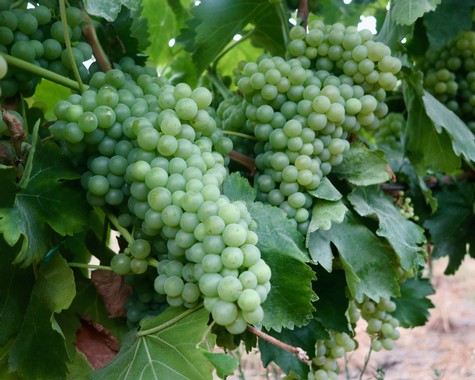
Hefty-sized Macabeu grapes in Bokisch's Miravet Vineyard.
While our walk through the vines lasted over an hour, the following is something of a summary of our conversation. In Mr. Bokisch's own words:
There are one and a half acres of each of the Cava varieties. This year [2023] will be our first year in which the vines produce a full load, about 7 tons each. We're looking at an early September pick for the Macabeo and Xarel-lo, and a just little later for the Parellada.
First, because we are just as interested as anyone to see how these grapes taste as non-sparkling varietal white wines, by spring of 2025 we will probably be selling the 2023 vintage of these wines separately as three varietal bottlings. They'll probably see a little bit of aging in neutral oak barrels, but we'll keep our minds open as we see these wines develop in the winery.
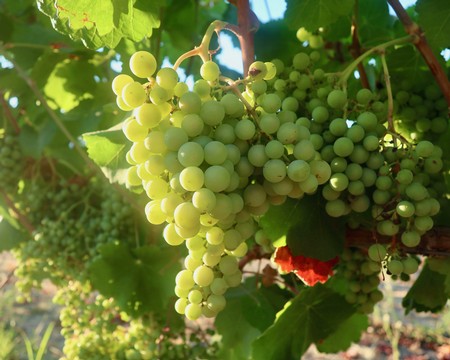
Parellada grapes in Bokisch's Miravet Vineyard, Clements Hills-Lodi AVA.
Of course, we'll make sparkling wines, which are called Cava in Spain. For sparklers, we'll probably pick the 2023 grapes at lower sugars, around 19° or 20° Brix (i.e., sugar reading) in order to emphasize freshness, lightness, and acidity. The still wines sold as varietals will probably be picked a little riper, at about 22° Brix.
Because these are classic Cava grapes, we will probably play with a few different blends. In Spain, each region, or each producer, favors certain blends, so it can vary. One producer's Cava may be based primarily on Macabeo, with smaller percentages of Parellada and Xarel-lo. Another producer may favor more Xarel-lo and less Macabeo or Parellada.
We don't know what will be the best combination for our style of sparkling wine, coming out of Miravet, because we still need to see what kinds of wines will come out of our soils and climate, although we did produce a tiny amount last year which is starting to give us a little idea of what we may be getting.
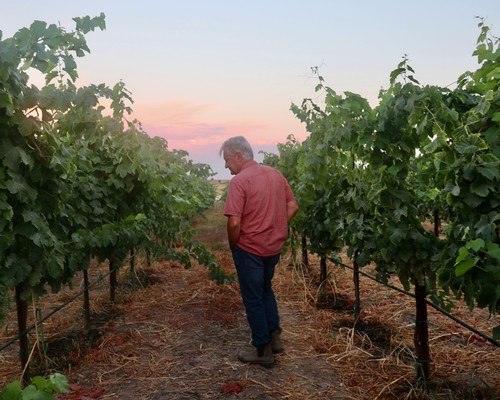
Markus Bokisch at the break of an August 2023 morning in his Miravet Vineyard.
We already know, for instance, that the Xarel-lo produces a more structured wine, with great acidity. That's the nature of Xarel-lo, which is why it is often bottled as a stand-alone white wine in the Penedès. I have no doubt that it will make an intriguing white wine here as well.
On top of that, most likely we'll do what they traditionally do in Spain, which is make variations of Cava. Our first sparkling wine release will be a wine that sees less bottle age, released within nine months. Cavas aged up to three years are more refined, and we'll want to explore that style as well. We'll time our sparkling wine releases in much the same way.
Macabeo (a.k.a., Viura)
Macabeo is the basis of Rioja whites and has had great success in Spain as a varietal. It is the consummate blending of white, producing a softer style of wine, ideal as a "filler." It makes wines with a good mouthfeel, giving an unctuous quality. The opposite of a grape-like Xarel-lo, which has much more of an acid/phenolic edge, resulting in edgier, more structured wines.
Macabeo is a prolific grower. We have already thinned this year's fruit in Miravet by over half, and we'll have to come back and drop even more. You can see these are generous-sized clusters, one and three/quarters to two-and-a-half pounds each. That's really something else!
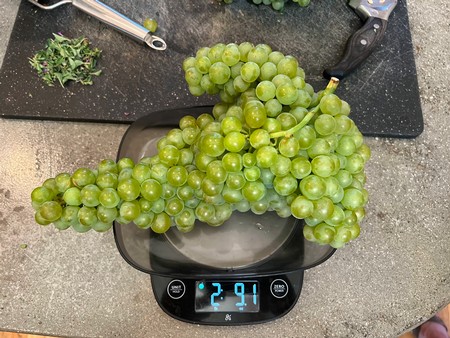
A single Miravet Vineyard Macabeu cluster (sample clipped last week), weighing more than 2.5 pounds.
Parellada
I don't know what exactly to expect out of Parellada here, but what we do know is that as a varietal this grape produces the most floral of the three Cava varieties. Our pick from last year [2022] seemed a little flabby, lacking a little bit of structure, but that could have been just the year because the vines put out an excess of fruit. The 2023 may be different. But you can already see, that out of all the Cava grapes, it is a very late ripener. Whereas the Macabeo and Xarel-lo clusters have already softened and are sugaring up, here in mid-August the Parellada clusters still consist of hard, little, green beads. They have a little way to go.
We have had experience of grapes evolving quite drastically over a period of time. During the first year or two of our Malbec from Linden Ridge [in the hillside regions south of Clements Hills], for example, none of us were impressed by what we saw. But after three years the grapes started coming around and we realized that the vineyard produces a very good, distinctive Malbec. I won't be surprised to see the Paraellada start to come along, either this year or next.
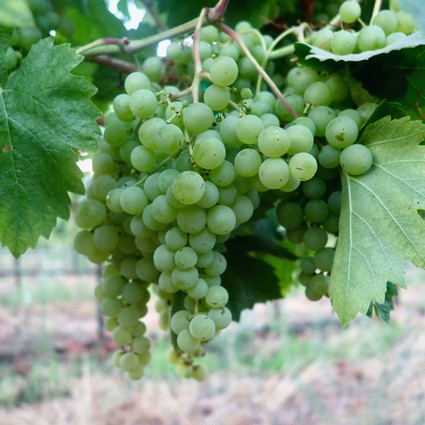
Xarel-lo cluster in Bokisch's Miravet Vineyard, Clements Hills-Lodi AVA.
Xarel-lo
You can see, and already taste, that this is the thickest skinned of the Cava grapes. It grows large, almost Chardonnay-like leaves. The clusters have a round, weighty, table grape-like quality, but the skins give white wines made from Xarel-lo a dense, phenolic character, which is accentuated by the higher acidity.
In a way, Xarel-lo is also a little like Albariño in that acids remain high while seed maturation is a little ahead of sugar [meaning, grapes ripen at lower sugars, allowing for zesty, lower alcohol wines]. We produced a super-interesting wine from Xarel-lo in 2022 because of that rapid fruit maturation. It's a great grape to have because in California most wine grapes are such sugar factories, which is why our wines are so fat and ripe. Xarel-lo's habit of ripening will be a big advantage in 2023, which has been a cooler climate year in which all grapes have become, essentially, "slower ripeners."
Lots to look forward to!
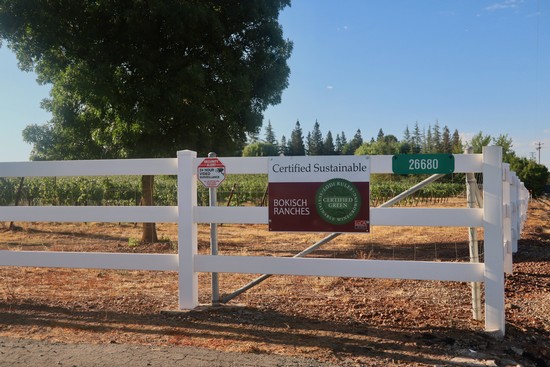
Entrance to Bokisch's Miravet Vineyard, certified by LODI RULES for Sustainable Winegrowing, in Lodi's Clements Hills AVA.